Exploring Social Media's Role in Consumer Holiday Decisions
VerifiedAdded on 2024/05/29
|35
|5903
|193
Report
AI Summary
This research report investigates the influence of social media on consumer holiday decision-making within the travel and tourism sector. It uses a combination of primary and secondary research methods, including online questionnaires and literature reviews, to explore the role and functions of social media in holiday planning. The study aims to understand how social media impacts travelers' choices, from initial information gathering to post-consumption evaluation. Ethical considerations and limitations of the research are addressed, and the findings contribute to understanding the implications of social media for the travel and tourism industry. The report includes an analysis of consumer decision-making models, the influence of online reviews, and the stages involved in holiday-related purchases. Ultimately, the research provides insights into how social media transforms the way tourists search for information, plan their trips, and interact with travel-related products and services. Desklib provides access to this and many other solved assignments for students.
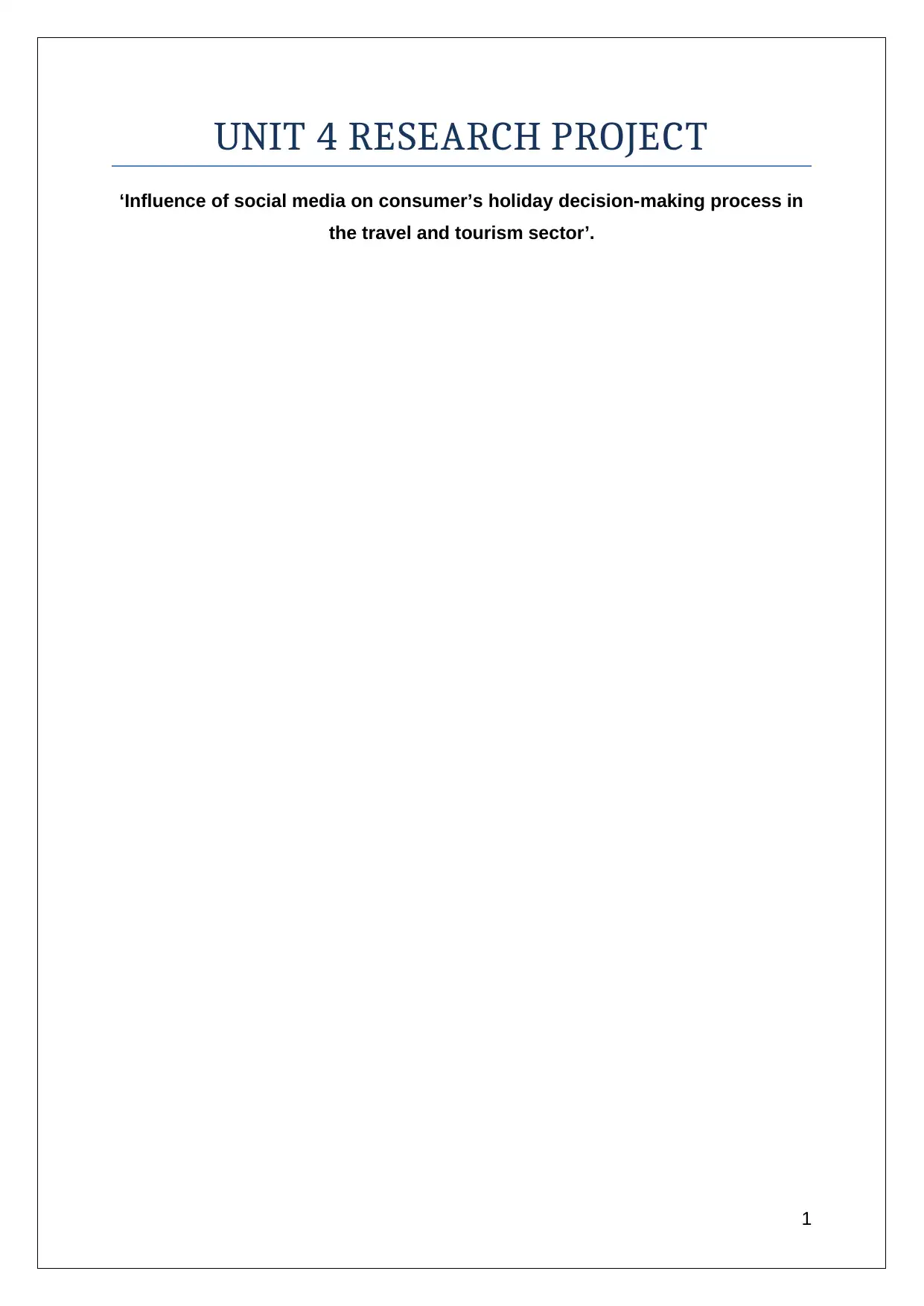
UNIT 4 RESEARCH PROJECT
‘Influence of social media on consumer’s holiday decision-making process in
the travel and tourism sector’.
1
‘Influence of social media on consumer’s holiday decision-making process in
the travel and tourism sector’.
1
Paraphrase This Document
Need a fresh take? Get an instant paraphrase of this document with our AI Paraphraser
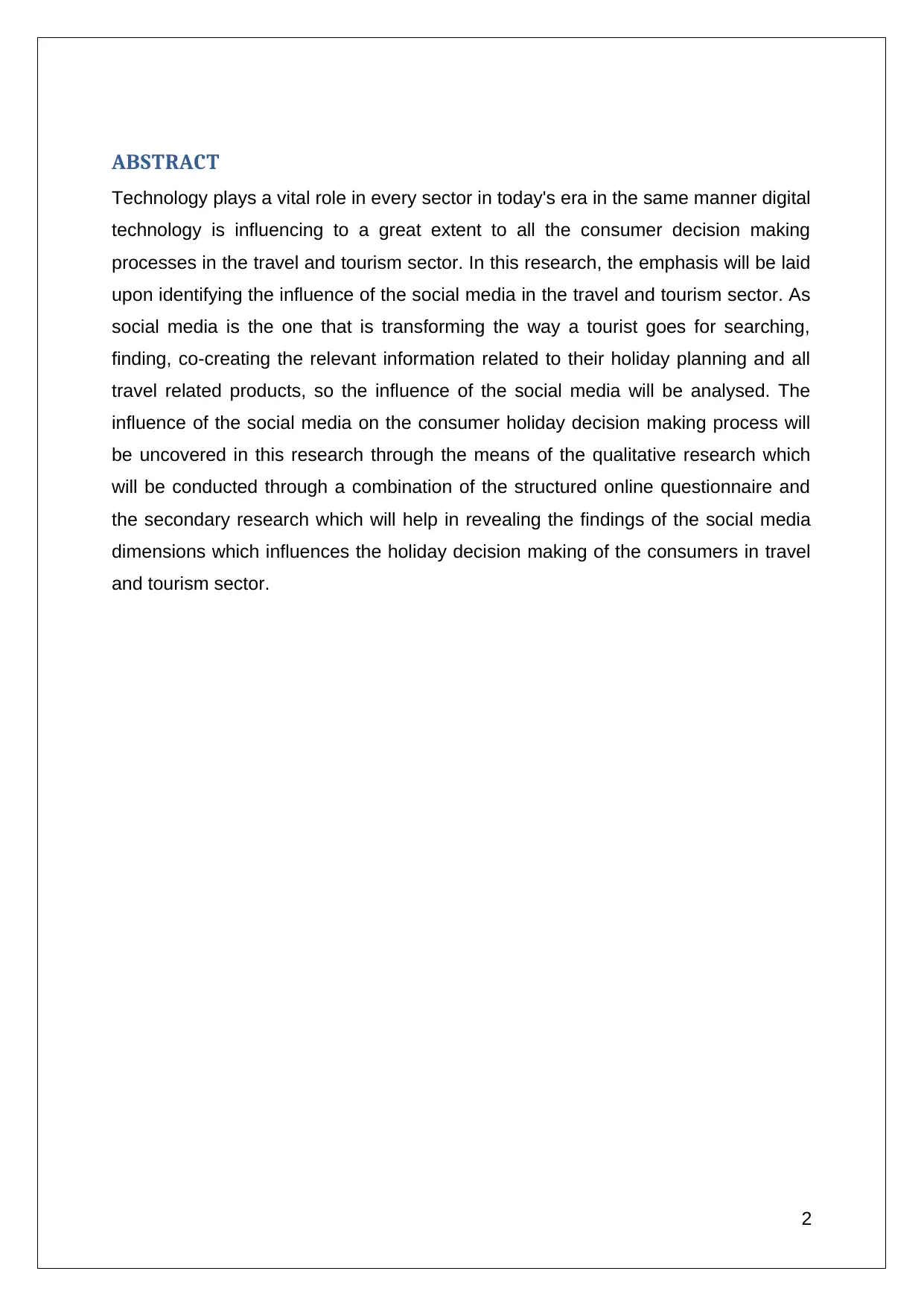
ABSTRACT
Technology plays a vital role in every sector in today's era in the same manner digital
technology is influencing to a great extent to all the consumer decision making
processes in the travel and tourism sector. In this research, the emphasis will be laid
upon identifying the influence of the social media in the travel and tourism sector. As
social media is the one that is transforming the way a tourist goes for searching,
finding, co-creating the relevant information related to their holiday planning and all
travel related products, so the influence of the social media will be analysed. The
influence of the social media on the consumer holiday decision making process will
be uncovered in this research through the means of the qualitative research which
will be conducted through a combination of the structured online questionnaire and
the secondary research which will help in revealing the findings of the social media
dimensions which influences the holiday decision making of the consumers in travel
and tourism sector.
2
Technology plays a vital role in every sector in today's era in the same manner digital
technology is influencing to a great extent to all the consumer decision making
processes in the travel and tourism sector. In this research, the emphasis will be laid
upon identifying the influence of the social media in the travel and tourism sector. As
social media is the one that is transforming the way a tourist goes for searching,
finding, co-creating the relevant information related to their holiday planning and all
travel related products, so the influence of the social media will be analysed. The
influence of the social media on the consumer holiday decision making process will
be uncovered in this research through the means of the qualitative research which
will be conducted through a combination of the structured online questionnaire and
the secondary research which will help in revealing the findings of the social media
dimensions which influences the holiday decision making of the consumers in travel
and tourism sector.
2
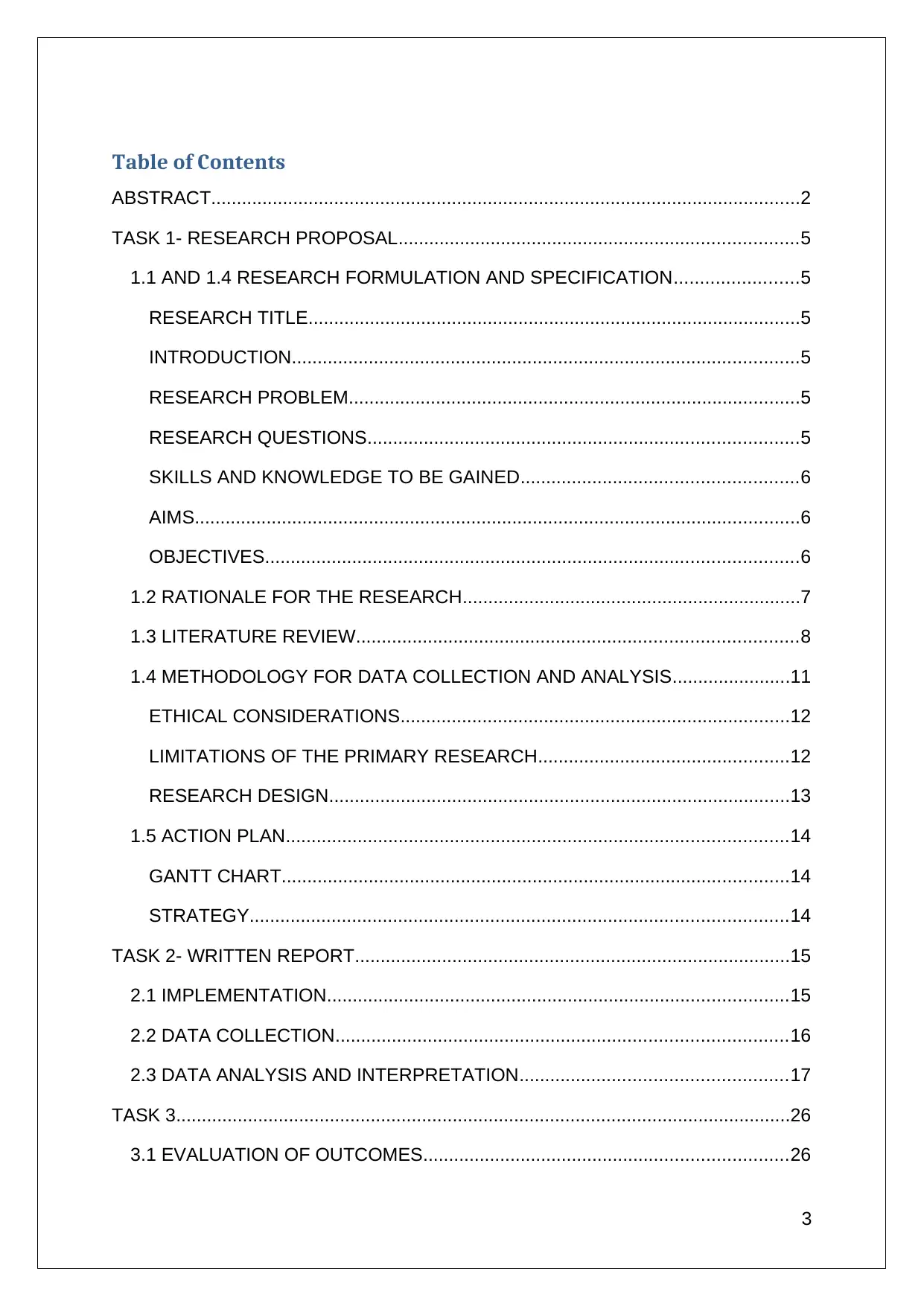
Table of Contents
ABSTRACT...................................................................................................................2
TASK 1- RESEARCH PROPOSAL..............................................................................5
1.1 AND 1.4 RESEARCH FORMULATION AND SPECIFICATION........................5
RESEARCH TITLE................................................................................................5
INTRODUCTION...................................................................................................5
RESEARCH PROBLEM........................................................................................5
RESEARCH QUESTIONS....................................................................................5
SKILLS AND KNOWLEDGE TO BE GAINED......................................................6
AIMS......................................................................................................................6
OBJECTIVES........................................................................................................6
1.2 RATIONALE FOR THE RESEARCH..................................................................7
1.3 LITERATURE REVIEW......................................................................................8
1.4 METHODOLOGY FOR DATA COLLECTION AND ANALYSIS.......................11
ETHICAL CONSIDERATIONS............................................................................12
LIMITATIONS OF THE PRIMARY RESEARCH.................................................12
RESEARCH DESIGN..........................................................................................13
1.5 ACTION PLAN..................................................................................................14
GANTT CHART...................................................................................................14
STRATEGY.........................................................................................................14
TASK 2- WRITTEN REPORT.....................................................................................15
2.1 IMPLEMENTATION..........................................................................................15
2.2 DATA COLLECTION........................................................................................16
2.3 DATA ANALYSIS AND INTERPRETATION....................................................17
TASK 3........................................................................................................................26
3.1 EVALUATION OF OUTCOMES.......................................................................26
3
ABSTRACT...................................................................................................................2
TASK 1- RESEARCH PROPOSAL..............................................................................5
1.1 AND 1.4 RESEARCH FORMULATION AND SPECIFICATION........................5
RESEARCH TITLE................................................................................................5
INTRODUCTION...................................................................................................5
RESEARCH PROBLEM........................................................................................5
RESEARCH QUESTIONS....................................................................................5
SKILLS AND KNOWLEDGE TO BE GAINED......................................................6
AIMS......................................................................................................................6
OBJECTIVES........................................................................................................6
1.2 RATIONALE FOR THE RESEARCH..................................................................7
1.3 LITERATURE REVIEW......................................................................................8
1.4 METHODOLOGY FOR DATA COLLECTION AND ANALYSIS.......................11
ETHICAL CONSIDERATIONS............................................................................12
LIMITATIONS OF THE PRIMARY RESEARCH.................................................12
RESEARCH DESIGN..........................................................................................13
1.5 ACTION PLAN..................................................................................................14
GANTT CHART...................................................................................................14
STRATEGY.........................................................................................................14
TASK 2- WRITTEN REPORT.....................................................................................15
2.1 IMPLEMENTATION..........................................................................................15
2.2 DATA COLLECTION........................................................................................16
2.3 DATA ANALYSIS AND INTERPRETATION....................................................17
TASK 3........................................................................................................................26
3.1 EVALUATION OF OUTCOMES.......................................................................26
3
⊘ This is a preview!⊘
Do you want full access?
Subscribe today to unlock all pages.

Trusted by 1+ million students worldwide
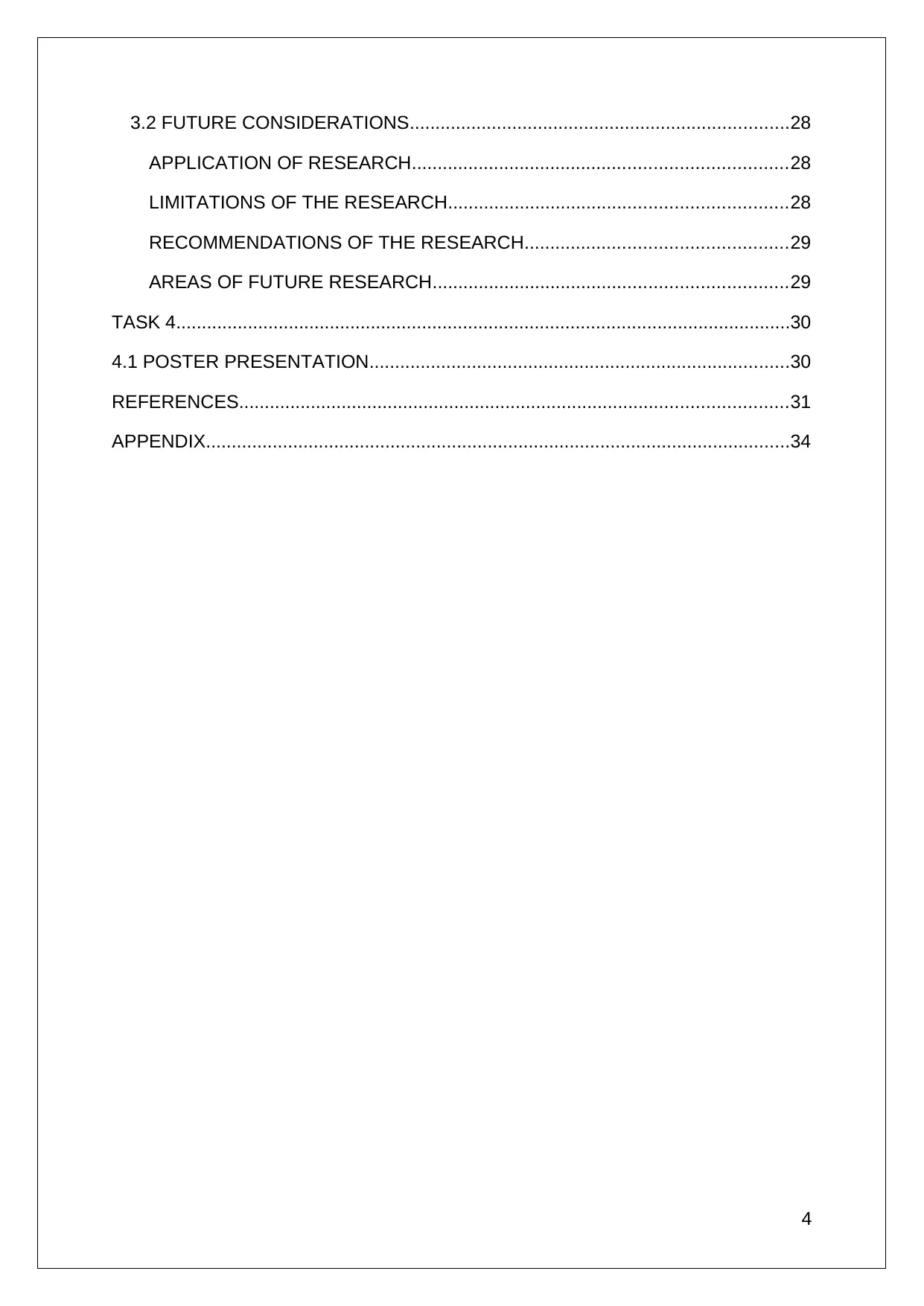
3.2 FUTURE CONSIDERATIONS..........................................................................28
APPLICATION OF RESEARCH.........................................................................28
LIMITATIONS OF THE RESEARCH..................................................................28
RECOMMENDATIONS OF THE RESEARCH...................................................29
AREAS OF FUTURE RESEARCH.....................................................................29
TASK 4........................................................................................................................30
4.1 POSTER PRESENTATION..................................................................................30
REFERENCES...........................................................................................................31
APPENDIX..................................................................................................................34
4
APPLICATION OF RESEARCH.........................................................................28
LIMITATIONS OF THE RESEARCH..................................................................28
RECOMMENDATIONS OF THE RESEARCH...................................................29
AREAS OF FUTURE RESEARCH.....................................................................29
TASK 4........................................................................................................................30
4.1 POSTER PRESENTATION..................................................................................30
REFERENCES...........................................................................................................31
APPENDIX..................................................................................................................34
4
Paraphrase This Document
Need a fresh take? Get an instant paraphrase of this document with our AI Paraphraser
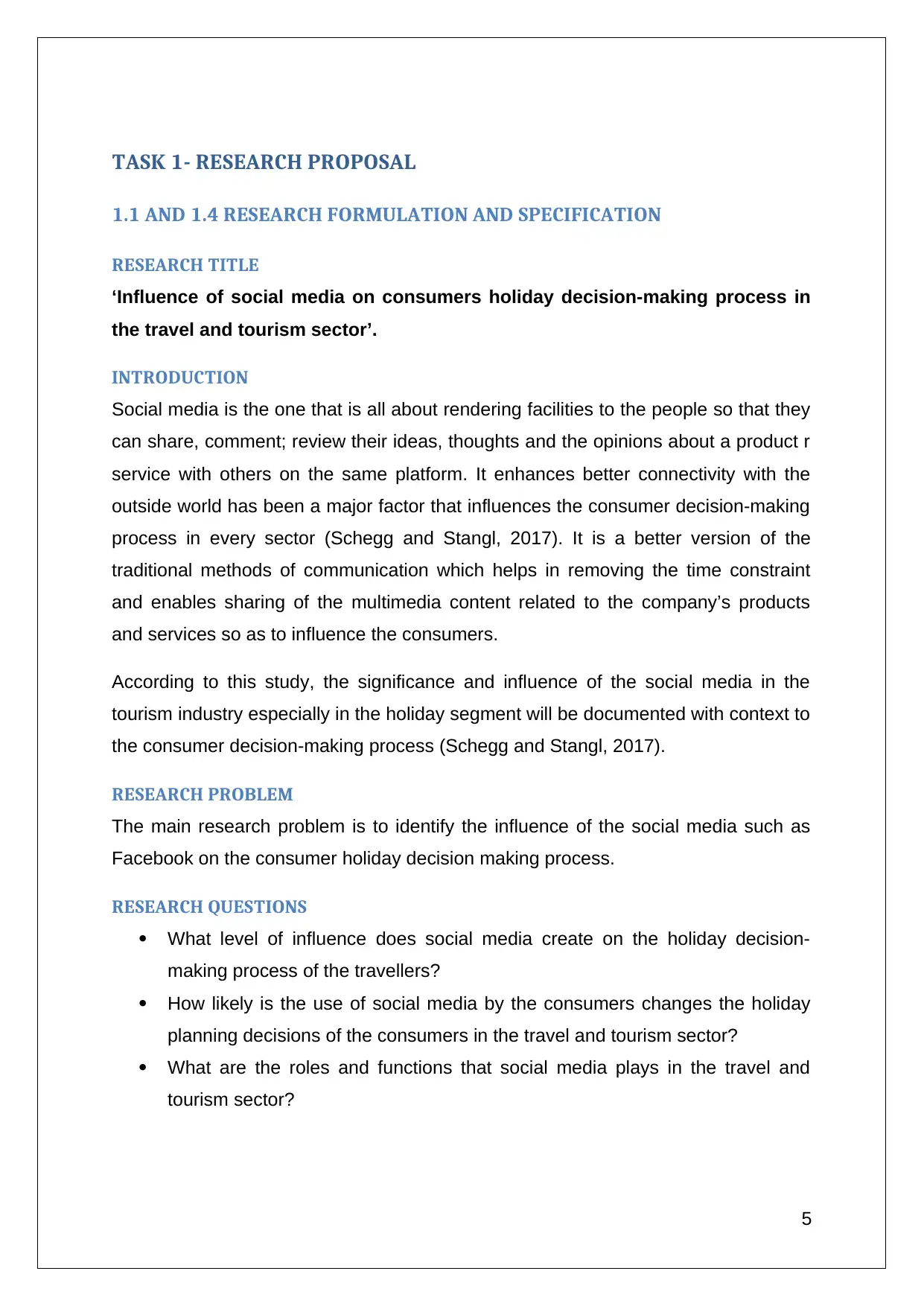
TASK 1- RESEARCH PROPOSAL
1.1 AND 1.4 RESEARCH FORMULATION AND SPECIFICATION
RESEARCH TITLE
‘Influence of social media on consumers holiday decision-making process in
the travel and tourism sector’.
INTRODUCTION
Social media is the one that is all about rendering facilities to the people so that they
can share, comment; review their ideas, thoughts and the opinions about a product r
service with others on the same platform. It enhances better connectivity with the
outside world has been a major factor that influences the consumer decision-making
process in every sector (Schegg and Stangl, 2017). It is a better version of the
traditional methods of communication which helps in removing the time constraint
and enables sharing of the multimedia content related to the company’s products
and services so as to influence the consumers.
According to this study, the significance and influence of the social media in the
tourism industry especially in the holiday segment will be documented with context to
the consumer decision-making process (Schegg and Stangl, 2017).
RESEARCH PROBLEM
The main research problem is to identify the influence of the social media such as
Facebook on the consumer holiday decision making process.
RESEARCH QUESTIONS
What level of influence does social media create on the holiday decision-
making process of the travellers?
How likely is the use of social media by the consumers changes the holiday
planning decisions of the consumers in the travel and tourism sector?
What are the roles and functions that social media plays in the travel and
tourism sector?
5
1.1 AND 1.4 RESEARCH FORMULATION AND SPECIFICATION
RESEARCH TITLE
‘Influence of social media on consumers holiday decision-making process in
the travel and tourism sector’.
INTRODUCTION
Social media is the one that is all about rendering facilities to the people so that they
can share, comment; review their ideas, thoughts and the opinions about a product r
service with others on the same platform. It enhances better connectivity with the
outside world has been a major factor that influences the consumer decision-making
process in every sector (Schegg and Stangl, 2017). It is a better version of the
traditional methods of communication which helps in removing the time constraint
and enables sharing of the multimedia content related to the company’s products
and services so as to influence the consumers.
According to this study, the significance and influence of the social media in the
tourism industry especially in the holiday segment will be documented with context to
the consumer decision-making process (Schegg and Stangl, 2017).
RESEARCH PROBLEM
The main research problem is to identify the influence of the social media such as
Facebook on the consumer holiday decision making process.
RESEARCH QUESTIONS
What level of influence does social media create on the holiday decision-
making process of the travellers?
How likely is the use of social media by the consumers changes the holiday
planning decisions of the consumers in the travel and tourism sector?
What are the roles and functions that social media plays in the travel and
tourism sector?
5
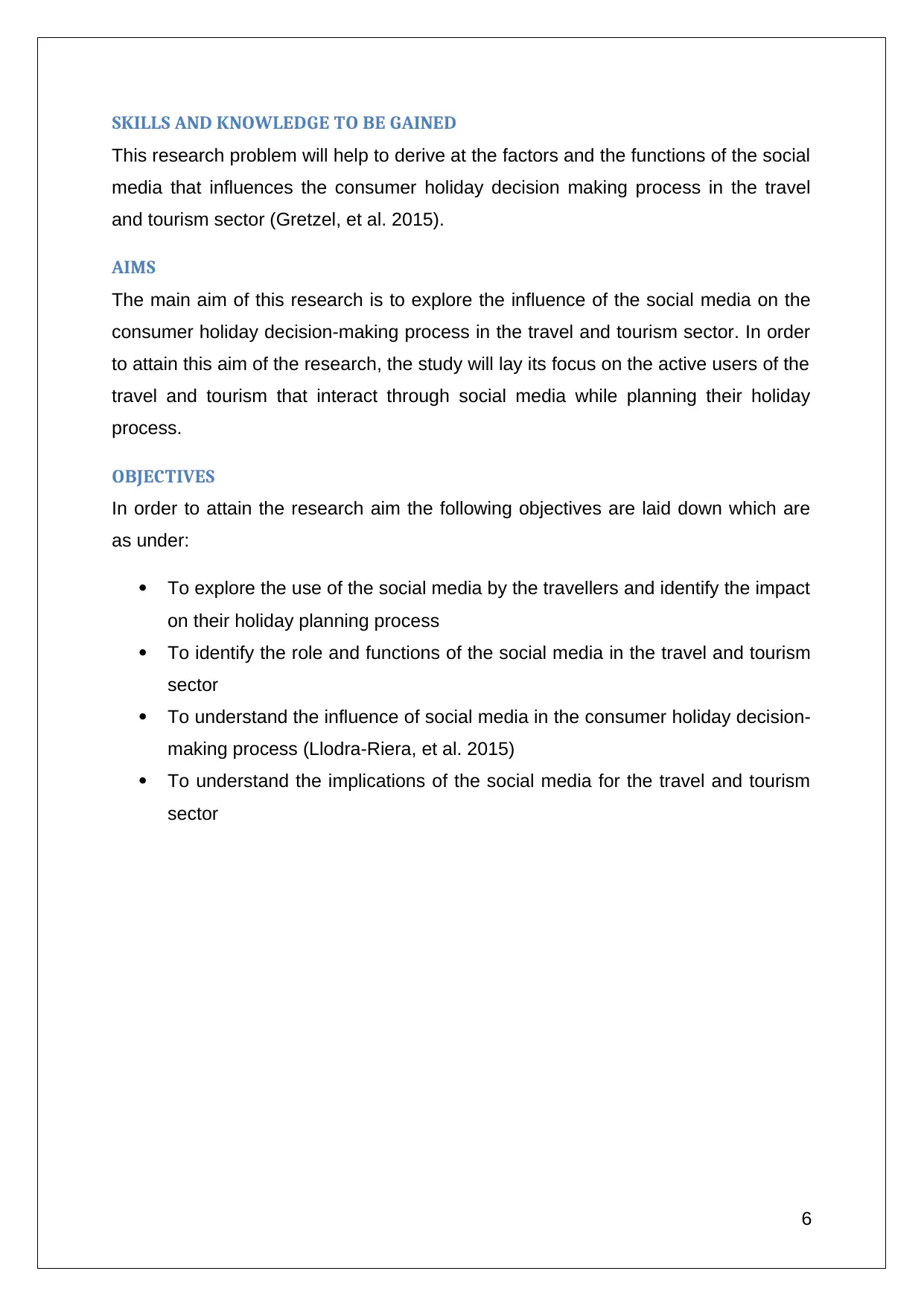
SKILLS AND KNOWLEDGE TO BE GAINED
This research problem will help to derive at the factors and the functions of the social
media that influences the consumer holiday decision making process in the travel
and tourism sector (Gretzel, et al. 2015).
AIMS
The main aim of this research is to explore the influence of the social media on the
consumer holiday decision-making process in the travel and tourism sector. In order
to attain this aim of the research, the study will lay its focus on the active users of the
travel and tourism that interact through social media while planning their holiday
process.
OBJECTIVES
In order to attain the research aim the following objectives are laid down which are
as under:
To explore the use of the social media by the travellers and identify the impact
on their holiday planning process
To identify the role and functions of the social media in the travel and tourism
sector
To understand the influence of social media in the consumer holiday decision-
making process (Llodra-Riera, et al. 2015)
To understand the implications of the social media for the travel and tourism
sector
6
This research problem will help to derive at the factors and the functions of the social
media that influences the consumer holiday decision making process in the travel
and tourism sector (Gretzel, et al. 2015).
AIMS
The main aim of this research is to explore the influence of the social media on the
consumer holiday decision-making process in the travel and tourism sector. In order
to attain this aim of the research, the study will lay its focus on the active users of the
travel and tourism that interact through social media while planning their holiday
process.
OBJECTIVES
In order to attain the research aim the following objectives are laid down which are
as under:
To explore the use of the social media by the travellers and identify the impact
on their holiday planning process
To identify the role and functions of the social media in the travel and tourism
sector
To understand the influence of social media in the consumer holiday decision-
making process (Llodra-Riera, et al. 2015)
To understand the implications of the social media for the travel and tourism
sector
6
⊘ This is a preview!⊘
Do you want full access?
Subscribe today to unlock all pages.

Trusted by 1+ million students worldwide
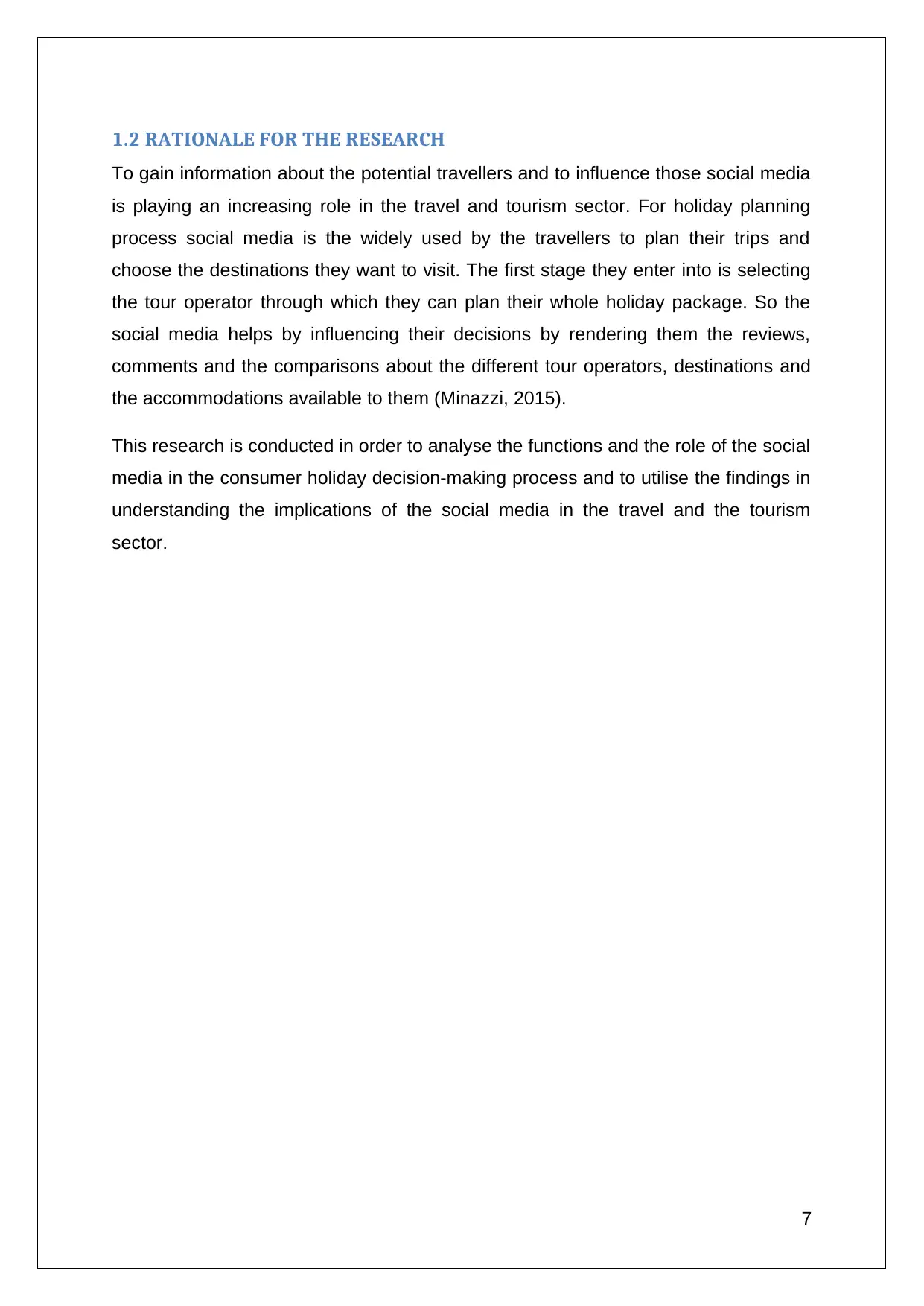
1.2 RATIONALE FOR THE RESEARCH
To gain information about the potential travellers and to influence those social media
is playing an increasing role in the travel and tourism sector. For holiday planning
process social media is the widely used by the travellers to plan their trips and
choose the destinations they want to visit. The first stage they enter into is selecting
the tour operator through which they can plan their whole holiday package. So the
social media helps by influencing their decisions by rendering them the reviews,
comments and the comparisons about the different tour operators, destinations and
the accommodations available to them (Minazzi, 2015).
This research is conducted in order to analyse the functions and the role of the social
media in the consumer holiday decision-making process and to utilise the findings in
understanding the implications of the social media in the travel and the tourism
sector.
7
To gain information about the potential travellers and to influence those social media
is playing an increasing role in the travel and tourism sector. For holiday planning
process social media is the widely used by the travellers to plan their trips and
choose the destinations they want to visit. The first stage they enter into is selecting
the tour operator through which they can plan their whole holiday package. So the
social media helps by influencing their decisions by rendering them the reviews,
comments and the comparisons about the different tour operators, destinations and
the accommodations available to them (Minazzi, 2015).
This research is conducted in order to analyse the functions and the role of the social
media in the consumer holiday decision-making process and to utilise the findings in
understanding the implications of the social media in the travel and the tourism
sector.
7
Paraphrase This Document
Need a fresh take? Get an instant paraphrase of this document with our AI Paraphraser
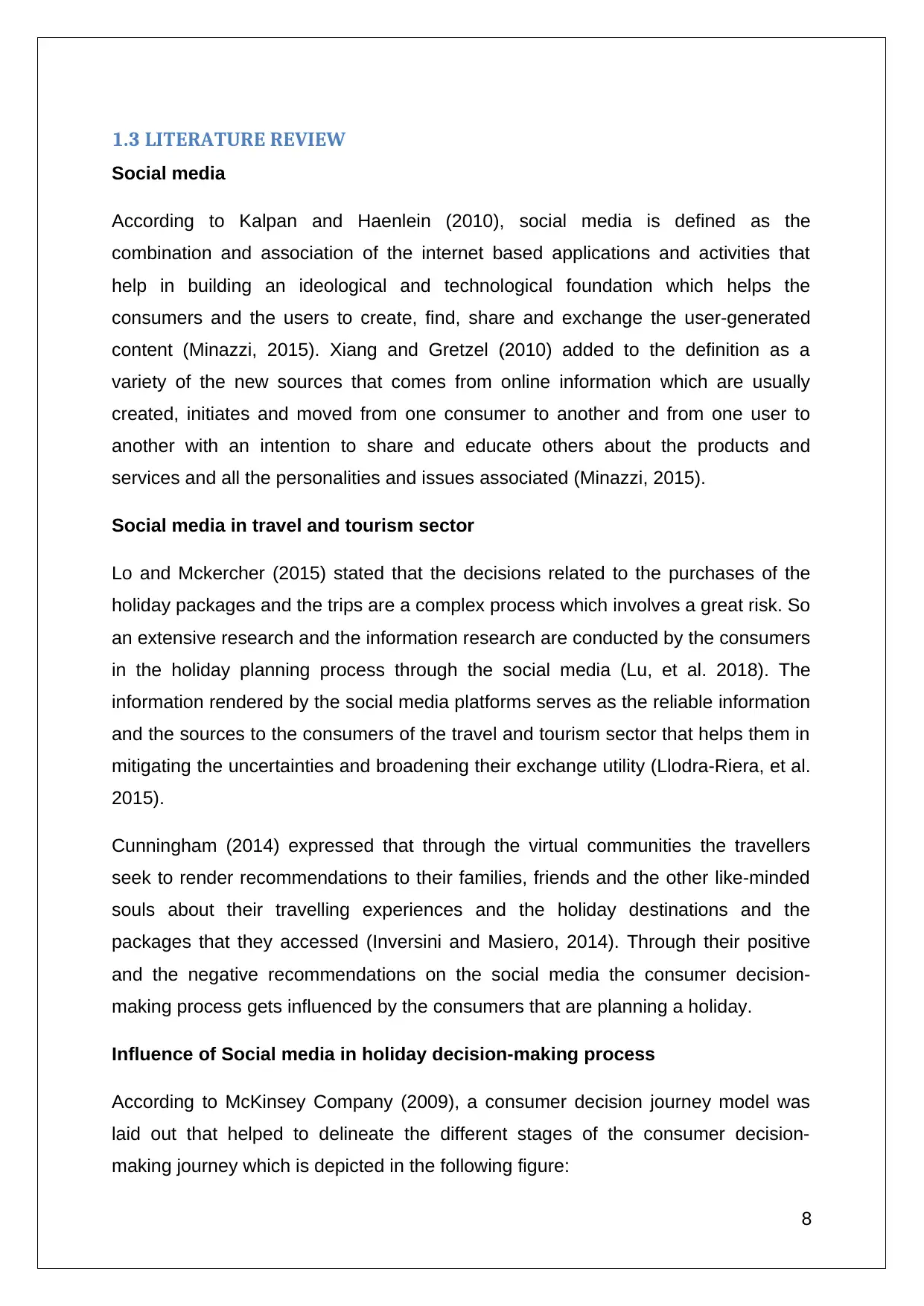
1.3 LITERATURE REVIEW
Social media
According to Kalpan and Haenlein (2010), social media is defined as the
combination and association of the internet based applications and activities that
help in building an ideological and technological foundation which helps the
consumers and the users to create, find, share and exchange the user-generated
content (Minazzi, 2015). Xiang and Gretzel (2010) added to the definition as a
variety of the new sources that comes from online information which are usually
created, initiates and moved from one consumer to another and from one user to
another with an intention to share and educate others about the products and
services and all the personalities and issues associated (Minazzi, 2015).
Social media in travel and tourism sector
Lo and Mckercher (2015) stated that the decisions related to the purchases of the
holiday packages and the trips are a complex process which involves a great risk. So
an extensive research and the information research are conducted by the consumers
in the holiday planning process through the social media (Lu, et al. 2018). The
information rendered by the social media platforms serves as the reliable information
and the sources to the consumers of the travel and tourism sector that helps them in
mitigating the uncertainties and broadening their exchange utility (Llodra-Riera, et al.
2015).
Cunningham (2014) expressed that through the virtual communities the travellers
seek to render recommendations to their families, friends and the other like-minded
souls about their travelling experiences and the holiday destinations and the
packages that they accessed (Inversini and Masiero, 2014). Through their positive
and the negative recommendations on the social media the consumer decision-
making process gets influenced by the consumers that are planning a holiday.
Influence of Social media in holiday decision-making process
According to McKinsey Company (2009), a consumer decision journey model was
laid out that helped to delineate the different stages of the consumer decision-
making journey which is depicted in the following figure:
8
Social media
According to Kalpan and Haenlein (2010), social media is defined as the
combination and association of the internet based applications and activities that
help in building an ideological and technological foundation which helps the
consumers and the users to create, find, share and exchange the user-generated
content (Minazzi, 2015). Xiang and Gretzel (2010) added to the definition as a
variety of the new sources that comes from online information which are usually
created, initiates and moved from one consumer to another and from one user to
another with an intention to share and educate others about the products and
services and all the personalities and issues associated (Minazzi, 2015).
Social media in travel and tourism sector
Lo and Mckercher (2015) stated that the decisions related to the purchases of the
holiday packages and the trips are a complex process which involves a great risk. So
an extensive research and the information research are conducted by the consumers
in the holiday planning process through the social media (Lu, et al. 2018). The
information rendered by the social media platforms serves as the reliable information
and the sources to the consumers of the travel and tourism sector that helps them in
mitigating the uncertainties and broadening their exchange utility (Llodra-Riera, et al.
2015).
Cunningham (2014) expressed that through the virtual communities the travellers
seek to render recommendations to their families, friends and the other like-minded
souls about their travelling experiences and the holiday destinations and the
packages that they accessed (Inversini and Masiero, 2014). Through their positive
and the negative recommendations on the social media the consumer decision-
making process gets influenced by the consumers that are planning a holiday.
Influence of Social media in holiday decision-making process
According to McKinsey Company (2009), a consumer decision journey model was
laid out that helped to delineate the different stages of the consumer decision-
making journey which is depicted in the following figure:
8
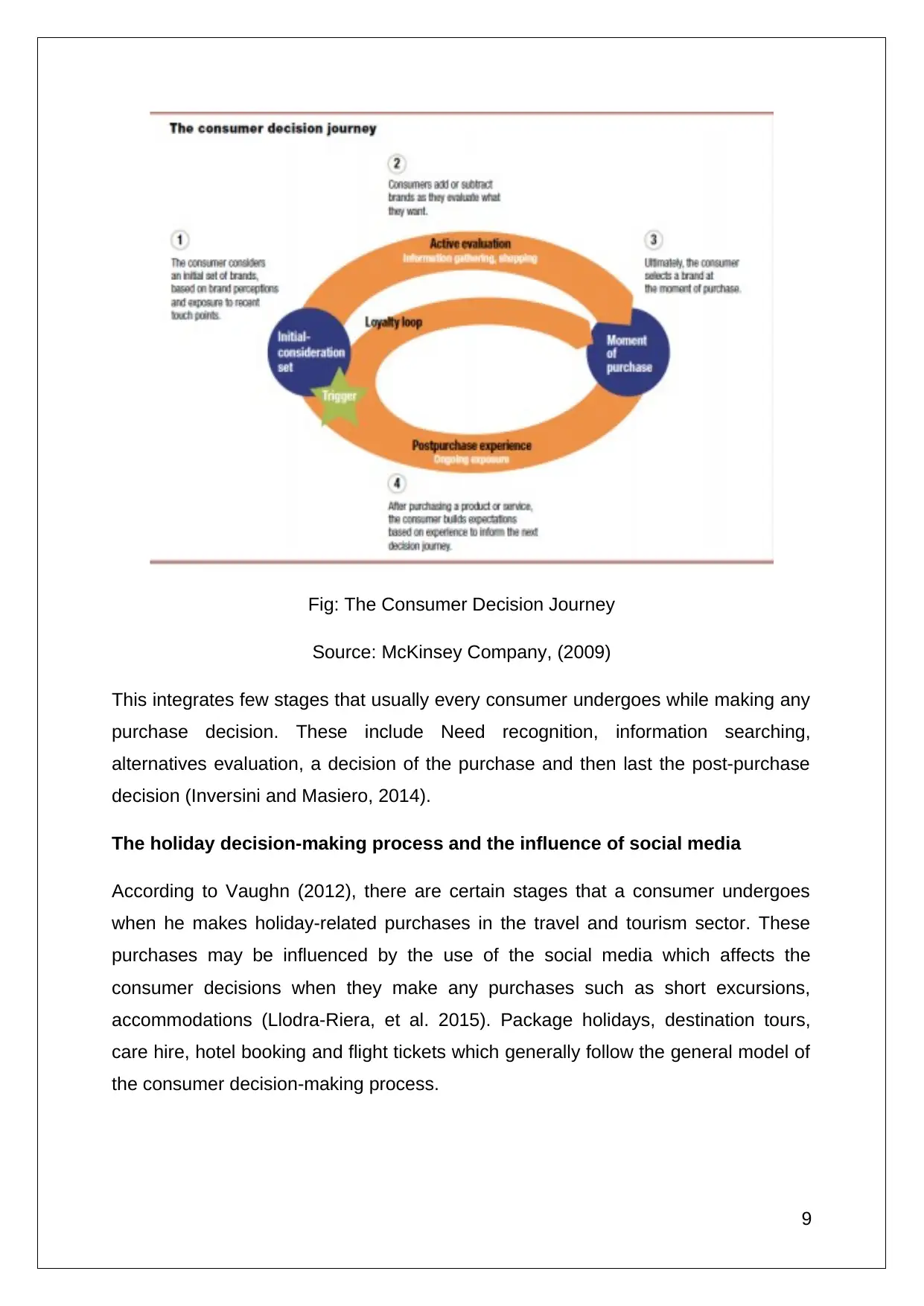
Fig: The Consumer Decision Journey
Source: McKinsey Company, (2009)
This integrates few stages that usually every consumer undergoes while making any
purchase decision. These include Need recognition, information searching,
alternatives evaluation, a decision of the purchase and then last the post-purchase
decision (Inversini and Masiero, 2014).
The holiday decision-making process and the influence of social media
According to Vaughn (2012), there are certain stages that a consumer undergoes
when he makes holiday-related purchases in the travel and tourism sector. These
purchases may be influenced by the use of the social media which affects the
consumer decisions when they make any purchases such as short excursions,
accommodations (Llodra-Riera, et al. 2015). Package holidays, destination tours,
care hire, hotel booking and flight tickets which generally follow the general model of
the consumer decision-making process.
9
Source: McKinsey Company, (2009)
This integrates few stages that usually every consumer undergoes while making any
purchase decision. These include Need recognition, information searching,
alternatives evaluation, a decision of the purchase and then last the post-purchase
decision (Inversini and Masiero, 2014).
The holiday decision-making process and the influence of social media
According to Vaughn (2012), there are certain stages that a consumer undergoes
when he makes holiday-related purchases in the travel and tourism sector. These
purchases may be influenced by the use of the social media which affects the
consumer decisions when they make any purchases such as short excursions,
accommodations (Llodra-Riera, et al. 2015). Package holidays, destination tours,
care hire, hotel booking and flight tickets which generally follow the general model of
the consumer decision-making process.
9
⊘ This is a preview!⊘
Do you want full access?
Subscribe today to unlock all pages.

Trusted by 1+ million students worldwide
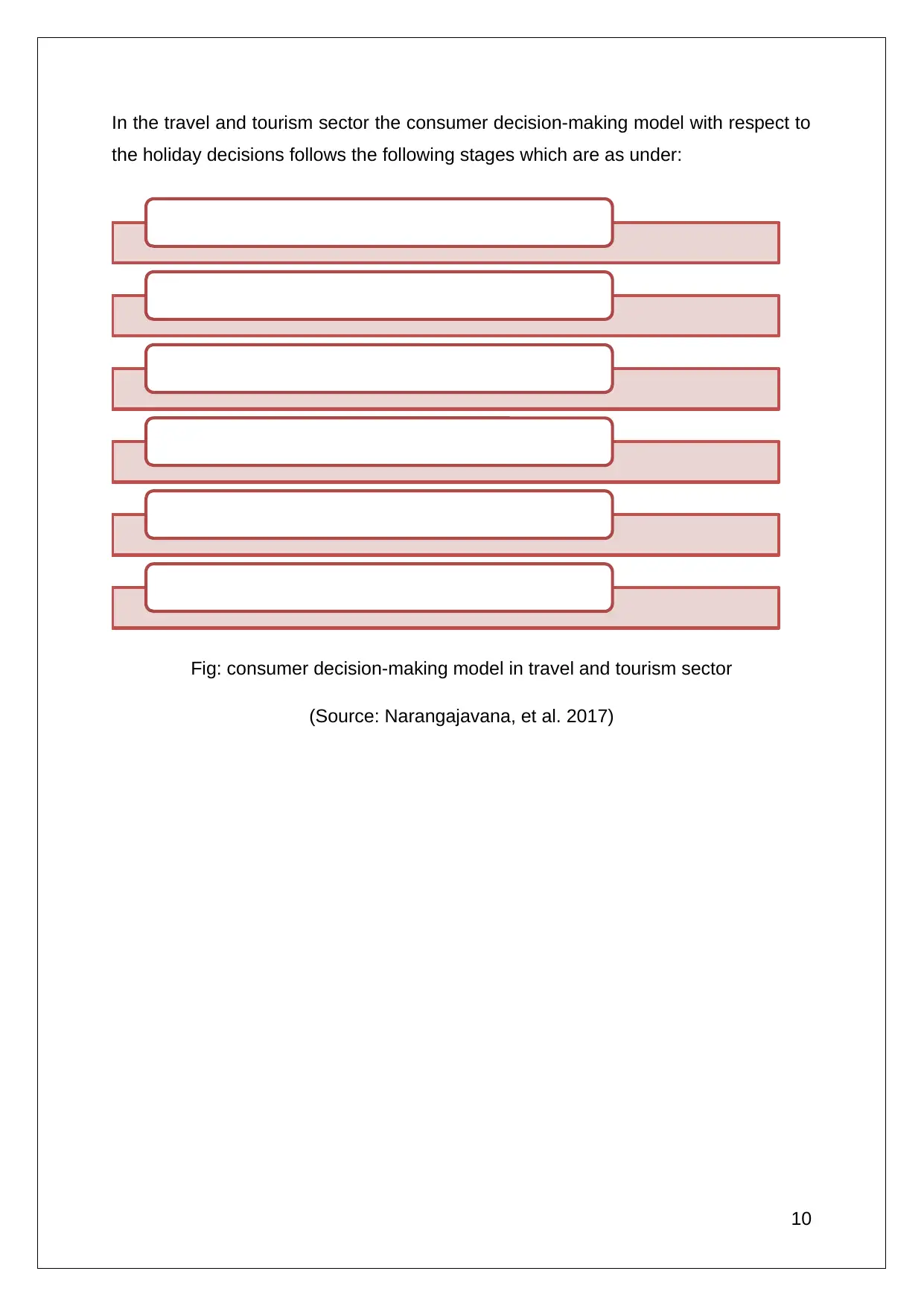
In the travel and tourism sector the consumer decision-making model with respect to
the holiday decisions follows the following stages which are as under:
Fig: consumer decision-making model in travel and tourism sector
(Source: Narangajavana, et al. 2017)
10
Need recognition
Information search
Evaluation of alternatives
Purchase decision
Consumption
Post consumption evaluation
the holiday decisions follows the following stages which are as under:
Fig: consumer decision-making model in travel and tourism sector
(Source: Narangajavana, et al. 2017)
10
Need recognition
Information search
Evaluation of alternatives
Purchase decision
Consumption
Post consumption evaluation
Paraphrase This Document
Need a fresh take? Get an instant paraphrase of this document with our AI Paraphraser
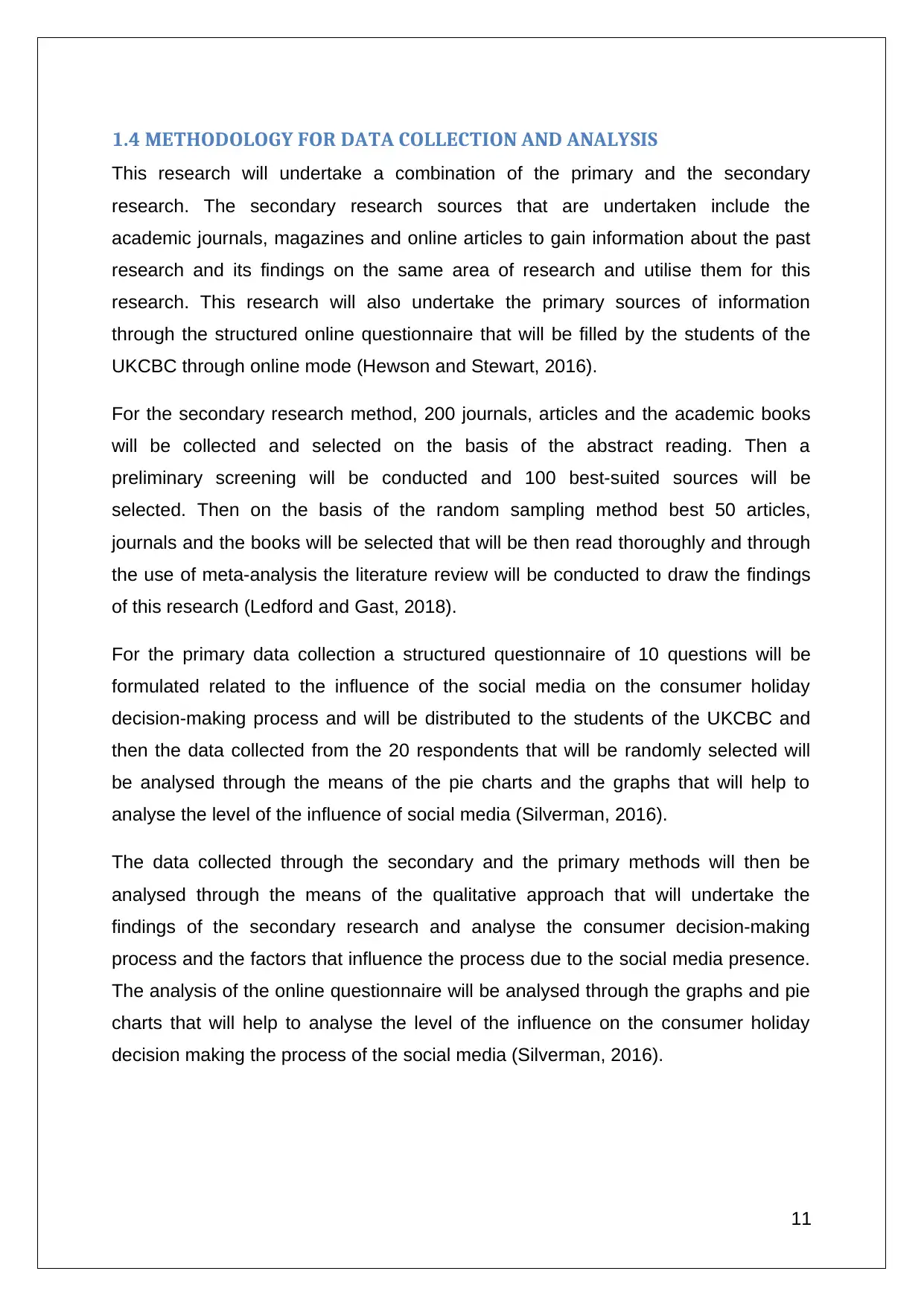
1.4 METHODOLOGY FOR DATA COLLECTION AND ANALYSIS
This research will undertake a combination of the primary and the secondary
research. The secondary research sources that are undertaken include the
academic journals, magazines and online articles to gain information about the past
research and its findings on the same area of research and utilise them for this
research. This research will also undertake the primary sources of information
through the structured online questionnaire that will be filled by the students of the
UKCBC through online mode (Hewson and Stewart, 2016).
For the secondary research method, 200 journals, articles and the academic books
will be collected and selected on the basis of the abstract reading. Then a
preliminary screening will be conducted and 100 best-suited sources will be
selected. Then on the basis of the random sampling method best 50 articles,
journals and the books will be selected that will be then read thoroughly and through
the use of meta-analysis the literature review will be conducted to draw the findings
of this research (Ledford and Gast, 2018).
For the primary data collection a structured questionnaire of 10 questions will be
formulated related to the influence of the social media on the consumer holiday
decision-making process and will be distributed to the students of the UKCBC and
then the data collected from the 20 respondents that will be randomly selected will
be analysed through the means of the pie charts and the graphs that will help to
analyse the level of the influence of social media (Silverman, 2016).
The data collected through the secondary and the primary methods will then be
analysed through the means of the qualitative approach that will undertake the
findings of the secondary research and analyse the consumer decision-making
process and the factors that influence the process due to the social media presence.
The analysis of the online questionnaire will be analysed through the graphs and pie
charts that will help to analyse the level of the influence on the consumer holiday
decision making the process of the social media (Silverman, 2016).
11
This research will undertake a combination of the primary and the secondary
research. The secondary research sources that are undertaken include the
academic journals, magazines and online articles to gain information about the past
research and its findings on the same area of research and utilise them for this
research. This research will also undertake the primary sources of information
through the structured online questionnaire that will be filled by the students of the
UKCBC through online mode (Hewson and Stewart, 2016).
For the secondary research method, 200 journals, articles and the academic books
will be collected and selected on the basis of the abstract reading. Then a
preliminary screening will be conducted and 100 best-suited sources will be
selected. Then on the basis of the random sampling method best 50 articles,
journals and the books will be selected that will be then read thoroughly and through
the use of meta-analysis the literature review will be conducted to draw the findings
of this research (Ledford and Gast, 2018).
For the primary data collection a structured questionnaire of 10 questions will be
formulated related to the influence of the social media on the consumer holiday
decision-making process and will be distributed to the students of the UKCBC and
then the data collected from the 20 respondents that will be randomly selected will
be analysed through the means of the pie charts and the graphs that will help to
analyse the level of the influence of social media (Silverman, 2016).
The data collected through the secondary and the primary methods will then be
analysed through the means of the qualitative approach that will undertake the
findings of the secondary research and analyse the consumer decision-making
process and the factors that influence the process due to the social media presence.
The analysis of the online questionnaire will be analysed through the graphs and pie
charts that will help to analyse the level of the influence on the consumer holiday
decision making the process of the social media (Silverman, 2016).
11
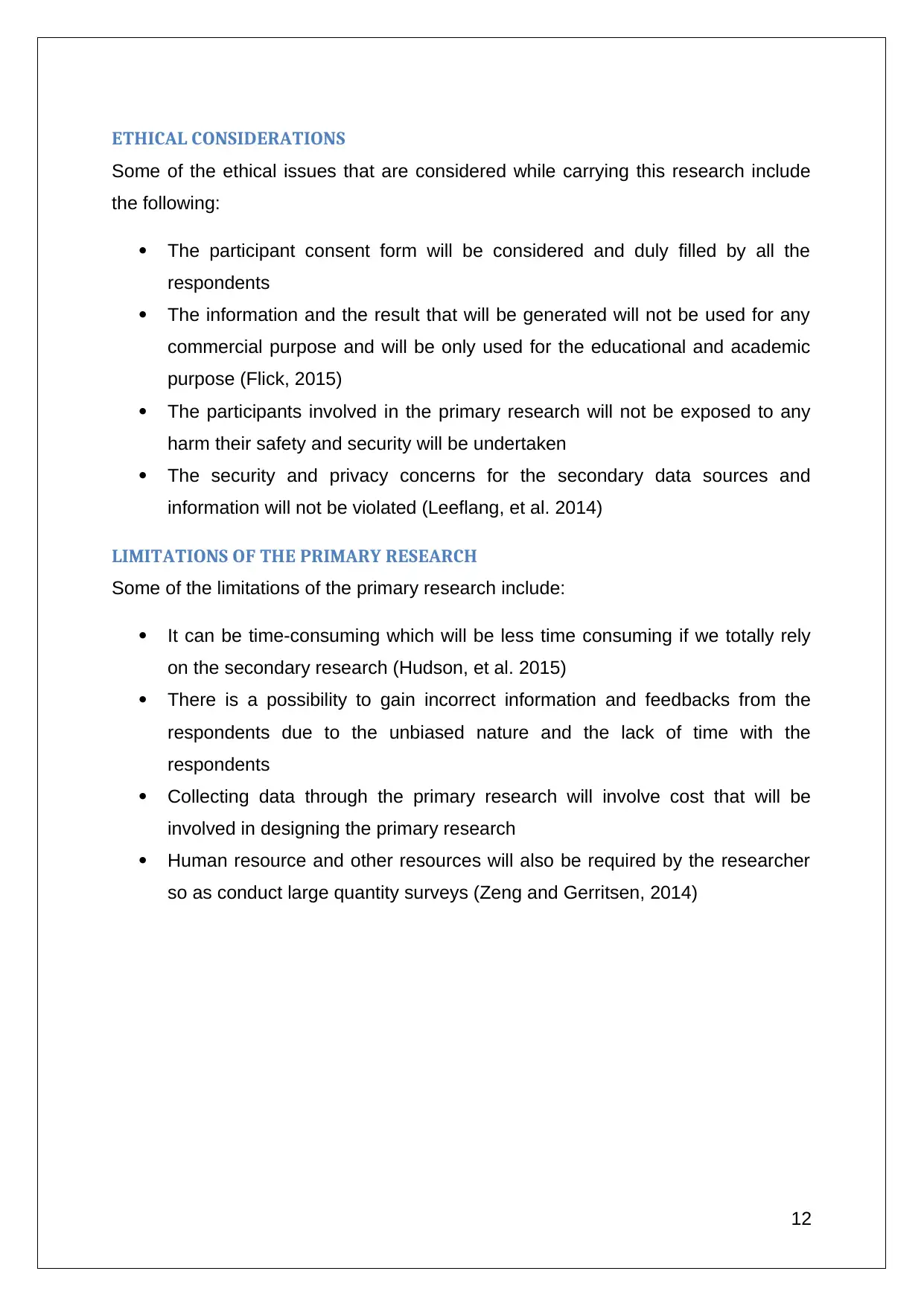
ETHICAL CONSIDERATIONS
Some of the ethical issues that are considered while carrying this research include
the following:
The participant consent form will be considered and duly filled by all the
respondents
The information and the result that will be generated will not be used for any
commercial purpose and will be only used for the educational and academic
purpose (Flick, 2015)
The participants involved in the primary research will not be exposed to any
harm their safety and security will be undertaken
The security and privacy concerns for the secondary data sources and
information will not be violated (Leeflang, et al. 2014)
LIMITATIONS OF THE PRIMARY RESEARCH
Some of the limitations of the primary research include:
It can be time-consuming which will be less time consuming if we totally rely
on the secondary research (Hudson, et al. 2015)
There is a possibility to gain incorrect information and feedbacks from the
respondents due to the unbiased nature and the lack of time with the
respondents
Collecting data through the primary research will involve cost that will be
involved in designing the primary research
Human resource and other resources will also be required by the researcher
so as conduct large quantity surveys (Zeng and Gerritsen, 2014)
12
Some of the ethical issues that are considered while carrying this research include
the following:
The participant consent form will be considered and duly filled by all the
respondents
The information and the result that will be generated will not be used for any
commercial purpose and will be only used for the educational and academic
purpose (Flick, 2015)
The participants involved in the primary research will not be exposed to any
harm their safety and security will be undertaken
The security and privacy concerns for the secondary data sources and
information will not be violated (Leeflang, et al. 2014)
LIMITATIONS OF THE PRIMARY RESEARCH
Some of the limitations of the primary research include:
It can be time-consuming which will be less time consuming if we totally rely
on the secondary research (Hudson, et al. 2015)
There is a possibility to gain incorrect information and feedbacks from the
respondents due to the unbiased nature and the lack of time with the
respondents
Collecting data through the primary research will involve cost that will be
involved in designing the primary research
Human resource and other resources will also be required by the researcher
so as conduct large quantity surveys (Zeng and Gerritsen, 2014)
12
⊘ This is a preview!⊘
Do you want full access?
Subscribe today to unlock all pages.

Trusted by 1+ million students worldwide
1 out of 35
Related Documents
Your All-in-One AI-Powered Toolkit for Academic Success.
+13062052269
info@desklib.com
Available 24*7 on WhatsApp / Email
![[object Object]](/_next/static/media/star-bottom.7253800d.svg)
Unlock your academic potential
Copyright © 2020–2025 A2Z Services. All Rights Reserved. Developed and managed by ZUCOL.





